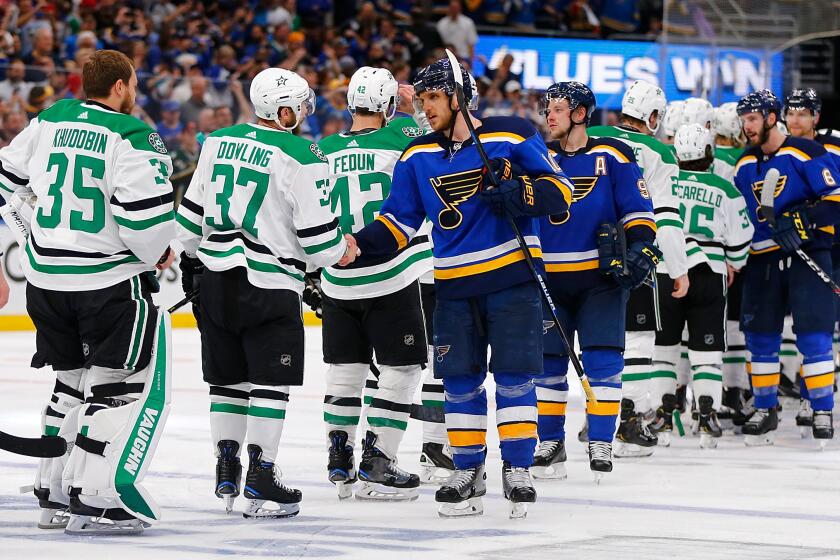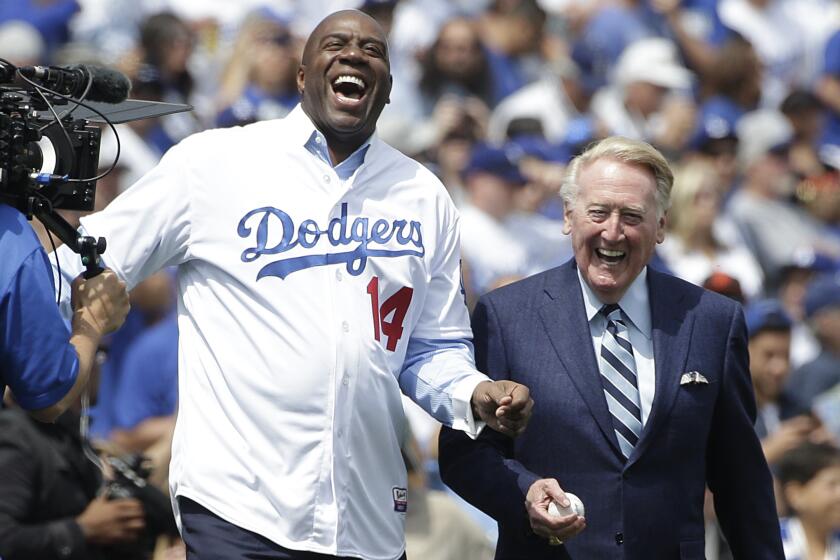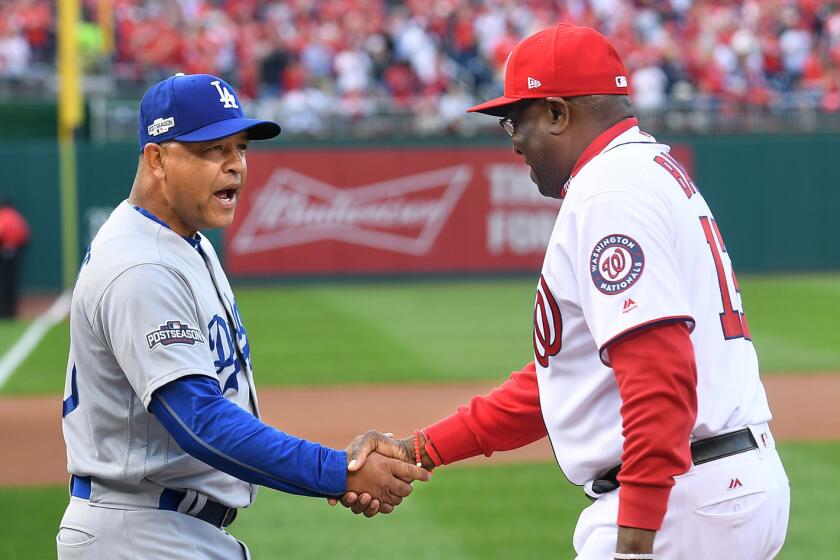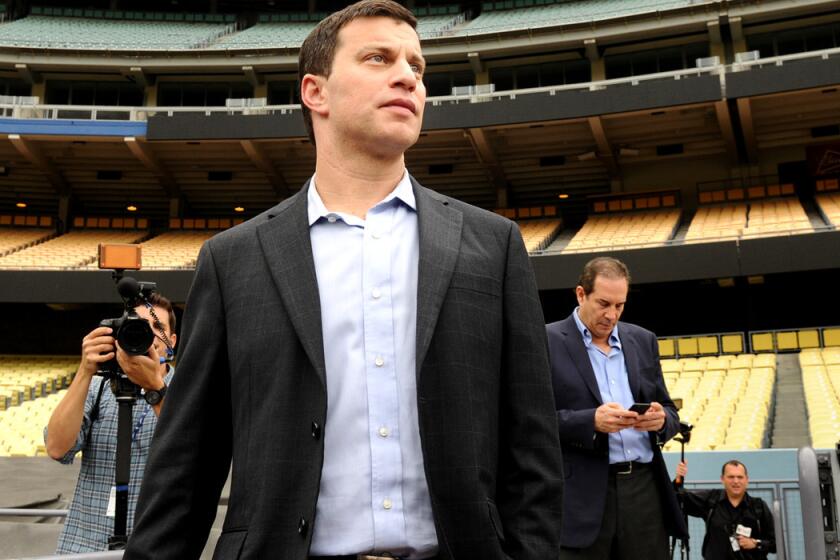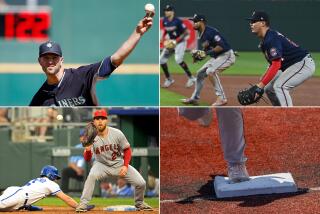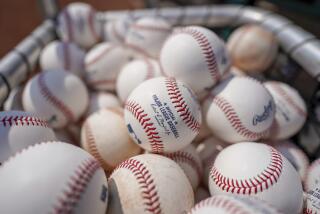How MLB proposes to protect players from the coronavirus
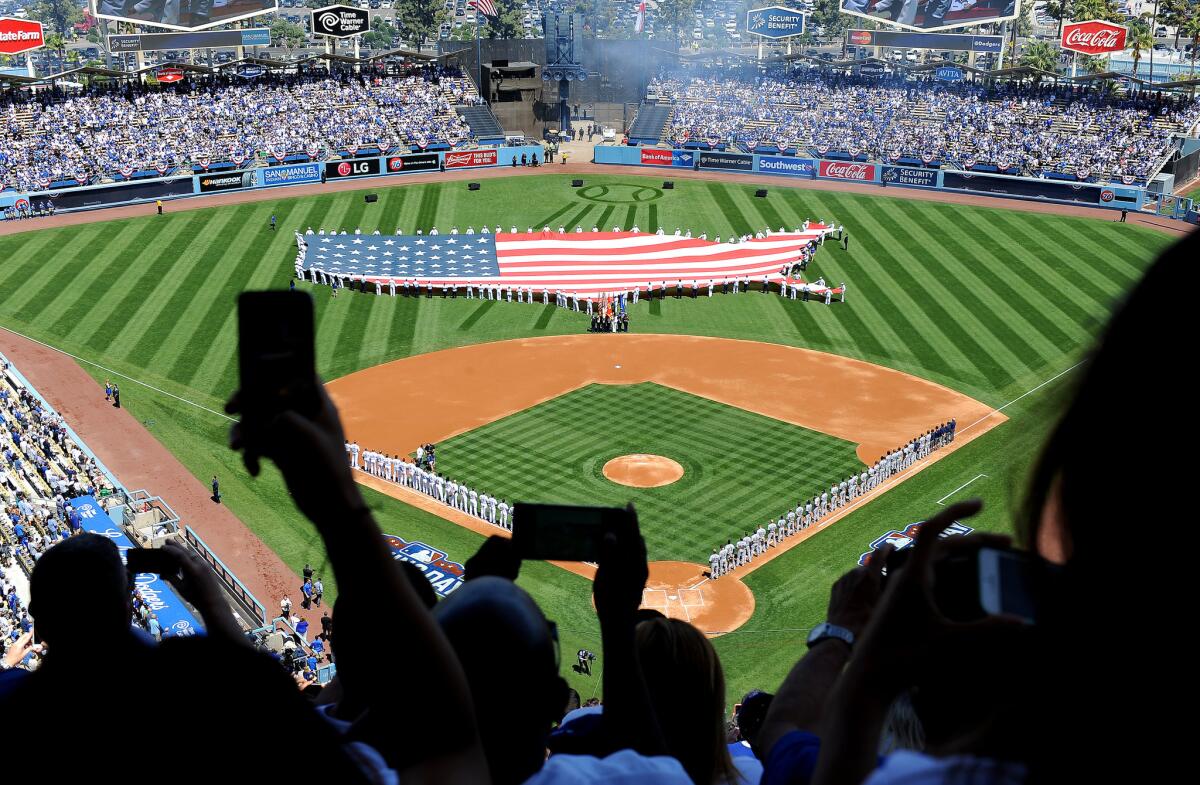
- Share via
Major League Baseball’s proposal to players for avoiding the spread of the novel coronavirus during a potential abbreviated season was obtained by The Times last weekend. The “2020 Operations Manual” is a hefty document but essential in addressing one of the two most crucial issues — money being the other — that the two sides must bridge before teams begin an abbreviated spring training.
Here are the most important takeaways from the manual’s 67 pages:
Chemistry-building won’t look the same
Athletes are creatures of habit. Some like to arrive at stadiums early to take advantage of the high-end equipment available to them. Some like to soak in the atmosphere of the clubhouse, cracking jokes or playing cards with teammates and support staff. However difficult it might be to define team chemistry, players see these moments as vital to the team’s success.
And they will pretty much cease to exist in 2020.
Individual locker stalls will be six feet apart, shrinking the number of people crammed into the space at one time. Physical distance will be maintained at all times. Masks will be worn except on the field and when engaging in strenuous activities, such as exercise. Individuals will be instructed to spend as little time indoors as possible.
The plan bans use of saunas, steam rooms, hot and cold tubs, hydrotherapy pools and cryotherapy chambers, all of which players utilize to accelerate muscle recovery. That could put players at greater risk of injury.
The coronavirus outbreak has athletes and medical experts from all over the world wondering how good sportsmanship can be embraced without shaking hands.
And that’s just the beginning
• Players will be encouraged to take batting practice outside whenever possible, so indoor batting cages will be off-limits more often than not. That probably means no postgame hitting sessions in the stadium tunnels.
• Buffets and food spreads will be eliminated and group dining will be discouraged. Teams will provide individually wrapped food directly to players, in take-out form.
• Most meetings will be conducted virtually. If that’s not possible, attendees will be physically distanced in meeting spaces and possibly asked to wear face coverings.
• Showering at the stadium will be discouraged.
• Use of exercise equipment will be staggered to avoid high-density indoor gatherings. MLB recommends teams relocate equipment outside, if possible, so they don’t have to worry about increasing ventilation for highly trafficked indoor spaces.
• Every month, each team’s highest-ranking baseball operations executive and medical staff member will be required to submit a form confirming their team’s cooperation with protocol.
Social distancing means reimagining social life
Restrictions will extend beyond the walls of the stadium and encroach on players’ personal lives. When on the road, Tier 1 and 2 individuals (see below), who are the only people allowed to travel with the team, must not …
• Eat or drink anywhere open to the public.
• Invite to their hotel rooms anyone not a member of the traveling party or an immediate family member.
• Use public hotel amenities.
• Leave the hotel for non-baseball activities without permission.
Returning home will provide only a limited reprieve. Tier 1 and 2 individuals will be expected — but not required — to spend as little time as possible in public spaces and around large groups. That means avoiding restaurants, bars, clubs and fitness centers.
It’s Magic Johnson versus Vin Scully in the finals of the Los Angeles Times’ tournament to determine L.A.’s biggest sports icon.
Tier what?
The people needed to run a season have been sorted by MLB into tiers and will have varying degrees of access to team facilities.
Players and members of the coaching staff, including trainers and bullpen catchers, will belong to Tier 1. So will umpires, though they will not count toward a team’s limit of 66 members in Tier 1. Up to 50 players, a manager, eight uniformed coaches, two bullpen catchers, two trainers, two team physicians and one strength and conditioning coach will be designated in this category.
Tier 2 includes front office and public relations staff, additional coaches and medical staff, video and replay personnel, clubhouse attendants, traveling secretaries, translators, the head groundskeeper and security personnel. No more than 35 individuals will be granted Tier 2 access. Attendants and staff in the visiting clubhouse and umpires’ room will not count toward the limit.
Up to 150 individuals will form Tier 3. The group will comprise, among others, broadcast personnel, groundskeepers, transportation providers, cleaning staff and security detail not assigned to restricted areas.
Those with Tier 1 clearance can access clubhouses, locker rooms, weight rooms, training rooms, batting cages, bullpens, playing fields and dugouts. Tier 2 individuals will also be allowed to enter areas frequented by on-field personnel, but will be encouraged to limit contact with those in Tier 1 and wear masks around Tier 1 individuals if doing so does not interfere with their job performance. Tier 3 personnel do not require close contact with Tier 1, according to the document, so they mostly will be confined to nonrestricted areas. They can access restricted areas when Tier 1 individuals are not present.
Members of the media will not be permitted to enter restricted areas or have close contact with Tier 1 individuals. MLB has not yet provided information regarding access to players and club personnel for interviews.
Celebrations will have to get more creative
The elaborate high-five routine players love to create and fans love to watch repeatedly on their cellphones? They won’t exist in 2020.
MLB will ban high-fives, hugs, fist bumps and every physical interaction not strictly necessary. Six feet of distance will separate individuals wherever possible. For instance, players will not stand shoulder to shoulder during the national anthem, the playing of “God Bless America” or any pregame ceremonies.
The in-game restrictions will look strange too. Fielders will be asked to take several steps away from the baserunner when the ball is out of play and between pitches. Will holding a runner be possible? Base coaches are expected not to approach a runner, fielder or umpire. Once they reach base, what will hitters do with the shinguards and elbow braces they normally remove?
Pitchers will be encouraged to use their own rosin bags and hitters their own pine tar and batting weights. Individuals will be instructed not to touch another’s equipment. Any communal equipment must be disinfected regularly throughout each game. The only people allowed in the dugout are Tier 1 individuals “who are necessary and active for the day’s game.” Anyone else can sit in the stands, spaced appropriately.
Fans chose the rosters. Now Dodgers manager Dave Roberts and Giants manager Gabe Kapler will choose starting lineups for the APBA SoCal vs. NorCal I-5 series.
Basic human behaviors will have to be modified or unlearned
• Spitting, chewing smokeless tobacco and eating sunflower seeds will not be allowed.
• Players and other on-field personnel will be encouraged to wash or sanitize their hands after each half-inning or after handling equipment.
• They will be asked to avoid touching their face with their hands, including to give signs, wiping away sweat with their hands, licking their fingers, whistling with their fingers and other such actions.
• Baseballs will be thrown out of play after they are touched by multiple people.
• Teams will be discouraged from throwing the ball around the infield.
Who gets tested? What if they’re positive?
Everyone in the three tiers will be subject to coronavirus and antibody tests before spring training commences, presumably in mid-June. After that, Tier 1 and 2 personnel will have body temperatures taken at home and when entering the stadium every day.
Players, coaches and umpires will be tested several times a week for the coronavirus, mostly using saliva tests, and occasionally for antibodies. The Sports Medicine Research and Testing Lab in Salt Lake City, which MLB uses for drug testing, will be converted into a COVID-19 testing site and provide test results within 24 hours.
Anyone who reports COVID-19 symptoms or has a temperature above 100 degrees will not be allowed into a team facility. He or she will be directed to self-isolate.
Those who test positive will quarantine, but not necessarily for the 14 days health officials recommended at the start of the pandemic. They will receive remote care from team medical staff. They will be released once they receive negative results from two tests analyzed by MLB’s Salt Lake City facility at least 24 hours apart.
Teams will conduct a contact-tracing investigation for the individuals believed to have been around the person who tested positive and arrange expedited diagnostic testing for them. Anyone exposed to COVID-19 can continue to work but must be asymptomatic. The individual will undergo more frequent temperature and health monitoring, be asked to wear a mask at all times except while on the field and be tested on a daily basis for at least seven days.
Additionally, anyone identified as high-risk by the team — either a person with underlying conditions or who lives with someone who could suffer severe illness as a result of COVID-19 — will not be allowed to enter any area visited by the person who tested positive without approval from MLB medical advisors.
MLB believes it can avoid a full shutdown in the event of a positive case because it will have been monitoring asymptomatic and symptomatic individuals since club facilities reopened for spring training.
While getting the Dodgers ready for a restart, Andrew Friedman, Dave Roberts and their wives are distributing meals to hospitals to feed front-line workers.
Wait, there’s more
• Teams might find themselves trucking their equipment city to city. Doing so would help them avoid touch points such as airport security checks.
• MLB wants individuals to avoid using elevators, so teams will be encouraged to book rooms on the lower floors of hotels and use stairs.
• Travelers will get used to returning to messy hotel rooms. Hotel staff will be expected to refrain from cleaning the interior of rooms during a team’s stay.
More to Read
Go beyond the scoreboard
Get the latest on L.A.'s teams in the daily Sports Report newsletter.
You may occasionally receive promotional content from the Los Angeles Times.
